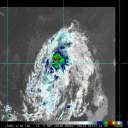Show Selection:
|
#1013855 (Received by flhurricane at: 4:48 PM 25.Aug.2020)
TCDAT3
Hurricane Laura Discussion Number 24
NWS National Hurricane Center Miami FL AL132020
400 PM CDT Tue Aug 25 2020
Satellite imagery shows some changes in the convective pattern of
Laura since the last advisory. The ragged central dense overcast
seen earlier has been replaced by a curved convective band that
wraps almost all the way around a cloud-filled banding-type eve. One
possible reason for this change is that the imagery also suggests a
tongue of dry air is trying to entrain into the cyclone just west of
the central convection. Aircraft data received after the last
advisory did not show any fall in the central pressure, but did have
high enough flight-level and SFMR winds to justify nudging the
initial intensity up to 70 kt.
The initial motion is now west-northwestward or 300/15 kt. There is
no change in the forecast philosophy since the last advisory. The
hurricane is currently on the south side of a large-deep layer ridge
over the southeastern United States, and it is moving toward a break
in the ridge caused by mid- to -upper-level troughing over Texas and
the southern Great Plains. The current and forecast synoptic
pattern should steer Laura west-northwestward this evening, followed
by a turn toward the northwest tonight and toward the north by
Wednesday night and Thursday. This will result in the hurricane
making landfall in the area of southwestern Louisiana or the upper
Texas coast late Wednesday night or Thursday morning. The new
forecast track has a slight eastward nudge during the first 12-24 h,
but the landfall position is almost unchanged from that of the
previous forecast. It should the be noted that the current forecast
track lies to the east of the ECMWF and UKMET models, so it is still
possible that the forecast track could nudge westward in later
advisories. After landfall, Laura is expected to recurve into the
westerlies and move eastward through the Tennessee Valley and the
mid-Atlantic States before reaching the Atlantic in about 120 h.
All indications are that the hurricane should steadily to rapidly
intensify during the next 24 h, with the only negative factor being
the possibility of more dry air entrainment. The intensity forecast
will go with the scenario that the dry air will not significantly
hinder strengthening. The global models are in good agreement that
Laura will encounter increasing southwesterly shear in the last 6-12
h before landfall, so the intensity forecast shows slower
strengthening during that time. With all that said, the landfall
intensity of 100 kt is unchanged from the previous advisory. After
landfall, Laura should weaken through the 96 h point, followed by
re-intensification through baroclinic energy as the cyclone becomes
extratropical.
Users are again reminded not to focus on the exact details of the
track or intensity forecasts as the average NHC track error at 36 h
is around 60 miles and the average intensity error is close to 10
mph. In addition, wind, storm surge, and rainfall hazards will
extend far from the center.
Key Messages:
1. There is a danger of life-threatening storm surge with large and
dangerous waves producing potentially catastrophic damage from San
Luis Pass, Texas, to the Mouth of the Mississippi River, including
areas inside the Port Arthur Hurricane Flood Protection system. This
surge could penetrate up to 30 miles inland from the immediate
coastline in southwestern Louisiana and far southeastern Texas.
Actions to protect life and property should be rushed to completion
this evening, as water levels will begin to rise on Wednesday.
2. Hurricane-force winds are expected Wednesday night in the warning
area from San Luis Pass, Texas, to west of Morgan City, Louisiana,
and the strongest winds associated with Laura`s eyewall will occur
somewhere within this area. Hurricane-force winds and widespread
damaging wind gusts are also expected to spread well inland into
portions of eastern Texas and western Louisiana early Thursday.
3. The threat of widespread flash and urban flooding along with
small streams overflowing their banks will increase due to heavy
rainfall Wednesday night into Thursday from far eastern Texas,
across Louisiana, and Arkansas. This will also result in minor to
isolated moderate river flooding. The heavy rainfall threat will
spread northeastward into the middle-Mississippi, lower Ohio and
Tennessee Valleys Friday night and Saturday.
FORECAST POSITIONS AND MAX WINDS
INIT 25/2100Z 24.7N 88.3W 70 KT 80 MPH
12H 26/0600Z 25.7N 90.3W 85 KT 100 MPH
24H 26/1800Z 27.5N 92.4W 95 KT 110 MPH
36H 27/0600Z 29.7N 93.8W 100 KT 115 MPH...ON COAST
48H 27/1800Z 32.2N 93.9W 65 KT 75 MPH...INLAND
60H 28/0600Z 34.7N 93.3W 40 KT 45 MPH...INLAND
72H 28/1800Z 36.5N 90.9W 30 KT 35 MPH...INLAND
96H 29/1800Z 38.5N 80.5W 25 KT 30 MPH...INLAND
120H 30/1800Z 42.0N 66.5W 40 KT 45 MPH...POST-TROP/EXTRATROP
$$
Forecaster Beven |



